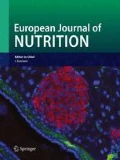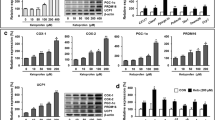Abstract
Purpose
Modern science has given much attention to the treatment of obesity by activating brown adipose tissue (BAT) and browning of white adipose tissue (WAT). Recent studies have identified theobromine, a derivative of cocoa, as a potent natural component actively browning white fat cells. Here, we aimed to deduce the anti-obesity effect of theobromine involving phosphodiesterase (PDE) dependent-regulatory pathway in obese animal models.
Methods
For examining activity of theobromine, C57BL/6 mice were fed with high fat diet and treated with theobromine to determine the expression levels of protein markers by immunoblot analysis and gene targets by quantitative real-time PCR. Other methods used include histopathological studies, immunofluorescence and molecular docking approaches.
Results
Theobromine alleviated diet-induced obesity in mice by browning of iWAT and activating BAT. Further, theobromine actively interacted with PDE4D and inhibited its activity in adipose tissues and cells potentiating energy expenditure. Moreover, the regulatory action of theobromine via inhibition of PDE4D was mediated by β3-AR signaling pathway.
Conclusion
Altogether, the current results signifies critical role of theobromine in reducing obesity by regulation of lipid metabolism through inhibition of PDE4, indicating its potential as a major therapeutic medicinal compound.






Similar content being viewed by others
Abbreviations
- ACOX1:
-
Acyl-coenzyme A oxidase 1
- AR:
-
Adrenergic receptor
- ATGL:
-
Adipose triglyceride lipase
- BAT:
-
Brown adipose tissue
- Cd137 :
-
Gene encoding tumor necrosis factor receptor superfamily member 9
- Cidea :
-
Gene encoding cell death-inducing DFFA-like effector a
- Cited1 :
-
Gene encoding Cbp/p300-interacting transactivator 1
- CPT1:
-
Carnitine palmitoyltransferase 1
- Eva1 :
-
Gene coding myelin protein zero like 2
- HSL:
-
Hormone-sensitive lipase
- Lhx8 :
-
Gene encoding LIM/homeobox protein Lhx8
- PDE-3/4:
-
Phosphodiesterase isoform ¾
- PGC-1α/Ppargc1α :
-
Peroxisome proliferator-activated receptor gamma co-activator 1-alpha/encoding gene
- PKA:
-
Protein kinase A
- PRDM16/Prdm16 :
-
PR domain-containing 16/encoding gene
- TB:
-
Theobromine
- Tbx1 :
-
Gene encoding T-box protein 1
- Tmem26 :
-
Gene encoding transmembrane protein 26
- UCP1/Ucp1 :
-
Uncoupling protein 1/encoding gene
- Zic1 :
-
Gene encoding zinc finger protein ZIC1
References
Hill JO, Wyatt HR, Peters JC (2012) Energy balance and obesity. Circulation 126:126–132
Wang W, Seale P (2016) Control of brown and beige fat development. Nat Rev Mol 17:691–702
Choe SS, Huh JY, Hwang IJ, Kim JI, Kim JB (2016) Adipose tissue remodeling: its role in energy metabolism and metabolic disorders. Front Endocrinol 7:30
Krauss S, Zhang CY, Lowell BB (2005) The mitochondrial uncoupling-protein homologues. Nat Rev Mol Cell Biol 6:248–261
Nedergaard J, Cannon B (2014) The browning of white adipose tissue: some burning issues. Cell Metab 20:396–407
Cypess AM, Lehman S, Williams G, Tal I, Rodman D, Goldfine AB, Kuo FC, Palmer EL, Tseng YH, Doria A, Kolodny GM, Kahn CR (2009) Identification and importance of brown adipose tissue in adult humans. N Engl J Med 360:1509–1517
Bartelt A, Heeren J (2014) Adipose tissue browning and metabolic health. Nat Rev Endocrinol 10:24–36
Silvester AJ, Aseer KR, Yun JW (2019) Dietary polyphenols and their roles in fat browning. J Nutr Biochem 64:1–12
Kaisanlahti A, Glumoff T (2019) Browning of white fat: agents and implications for beige adipose tissue to type 2 diabetes. J Physiol Biochem 75:1–10
Carrageta DF, Dias TR, Alves MG, Oliveira PF, Monteiro MP, Silva BM (2018) Anti-obesity potential of natural methylxanthines. J Funct Food 43:83–94
Arnaud MJ (2011) Pharmacokinetics and metabolism of natural methylxanthines in animal and man. Handb Exp Pharmacol 200:33–91
Monteiro J, Alves MG, Oliveira PF, Silva BM (2018) Pharmacological potential of methylxanthines: retrospective analysis and future expectations. Crit Rev Food Sci Nutr 61:1–29
Papadimitriou A, Silva KC, Peixoto EB, Borges CM, Lopes de Faria JM, Lopes de Faria JB (2015) Theobromine increases NAD+/Sirt-1 activity and protects the kidney under diabetic conditions. Am J Physiol Renal Physiol 308:F209–225
Jang YJ, Koo HJ, Sohn EH, Kang SC, Rhee DK, Pyo S (2015) Theobromine inhibits differentiation of 3T3-L1 cells during the early stage of adipogenesis via AMPK and MAPK signaling pathways. Food Funct 6:2365–2374
Martín-Peláez S, Camps-Bossacoma M, Massot-Cladera M, Rigo-Adrover M, Franch À, Pérez-Cano FJ, Castell M (2017) Effect of cocoa's theobromine on intestinal microbiota of rats. Mol Nutr Food Res. https://doi.org/10.1002/mnfr.201700238
Jacobs DM, Smolders L, Lin Y, Roo N, Trautwein EA, van Duynhoven J, Mensink RP, Plat J, Mihaleva VV (2017) Effect of theobromine consumption on serum lipoprotein profiles in apparently healthy humans with low HDL-cholesterol concentrations. Front Mol Biosci 4:59
Eteng MH, Ibekwe HA, Umoh U, Ebong P, Umoh I, Eyong EU (2006) Theobromine rich cocoa powder induces weight loss and changes in lipid profile of obese Wistar rats. Discov Innov 18:191–196
Jang MH, Kang NH, Sulagna M, Yun JW (2018) Theobromine, a methylxanthine in cocoa bean, stimulates thermogenesis by inducing white fat browning and activating brown adipocytes. Biotechnol Bioproc E 23:617–626
Dulloo AG, Seydoux J, Girardier L (1992) Potentiation of the thermogenic antiobesity effects of ephedrine by dietary methylxanthines: adenosine antagonism or phosphodiesterase inhibition? Metabolism 41:1233–1241
Conti M, Richter W, Mehats C, Livera G, Park JY, Jin C (2003) Cyclic AMP-specific PDE4 phosphodiesterases as critical components of cyclic AMP signaling. J Biol Chem 278:5493–5496
Snyder PB, Esselstyn JM, Loughney K, Wolda SL, Florio VA (2005) The role of cyclic nucleotide phosphodiesterases in the regulation of adipocyte lipolysis. J Lipid Res 46:494–503
Zhang R, Maratos-Flier E, Flier JS (2009) Reduced adiposity and high-fat diet-induced adipose inflammation in mice deficient for phosphodiesterase 4B. Endocrinology 150:3076–3082
Armani A, Marzolla V, Rosano GM, Fabbri A, Caprio M (2011) Phosphodiesterase type 5 (PDE5) in the adipocyte: a novel player in fat metabolism? Trends Endocrinol Metab 22:404–411
Omar B, Banke E, Ekelund M, Frederiksen S, Degerman E (2011) Alterations in cyclic nucleotide phosphodiesterase activities in omental and subcutaneous adipose tissues in human obesity. Nutr Diabetes 1:e13
Kraynik SM, Miyaoka RS, Beavo JA (2013) PDE3 and PDE4 isozyme-selective inhibitors are both required for synergistic activation of brown adipose tissue. Mol Pharmacol 83:1155–1165
Wu C, Rajagopalan S (2016) Phosphodiesterase-4 inhibition as a therapeutic strategy for metabolic disorders. Obes Rev 17:429–441
Sugimoto N, Miwa S, Hitomi Y, Nakamura H, Tsuchiya H, Yachie A (2014) Theobromine, the primary methylxanthine found in Theobroma cacao, prevents malignant glioblastoma proliferation by negatively regulating phosphodiesterase-4, extracellular signal-regulated kinase, Akt/mammalian target of rapamycin kinase, and nuclear factor-kappa B. Nutr Cancer 66:419–423
Rasouli M, Zahraie M (2006) Suppression of VLDL associated triacylglycerol secretion by both alpha- and beta-adrenoceptor agonists in isolated rat hepatocytes. Eur J Pharmacol 545:109–114
Green RD, Stanberry LR (1977) Elevation of cyclic AMP in C-1300 murine neuroblastoma by adenosine and related compounds and the antagonism of this response by methylxanthines. Biochem Pharmacol 26:37–43
Houslay MD, Schafer P, Zhang KY (2005) Keynote review: phosphodiesterase-4 as a therapeutic target. Drug Discov Today 10:1503–1519
Lugnier C (2011) PDE inhibitors: a new approach to treat metabolic syndrome? Curr Opin Pharmacol 11:698–706
Hankir MK, Kranz M, Gnad T, Weiner J, Wagner S, Deuther-Conrad W, Bronisch F, Steinhoff K, Luthardt J, Klöting N, Hesse S, Seibyl JP, Sabri O, Heiker JT, Blüher M, Pfeifer A, Brust P, Fenske WK (2016) A novel thermoregulatory role for PDE10A in mouse and human adipocytes. EMBO Mol Med 8:796–812
Kim NJ, Baek JH, Lee J, Kim H, Song JK, Chun KH (2019) A PDE1 inhibitor reduces adipogenesis in mice via regulation of lipolysis and adipogenic cell signaling. Exp Mol Med 51:5
Feinstein WP, Brylinski M (2015) Calculating an optimal box size for ligand docking and virtual screening against experimental and predicted binding pockets. J Cheminform 7:18
Kundu I, Paul G, Banerjee R (2018) A machine learning approach towards the prediction of protein-ligand binding affinity based on fundamental molecular properties. RSC Adv 8:12127–12137
Schudt C, Hatzelmann A, Beume R, Tenor H (2011) Phosphodiesterase inhibitors: history of pharmacology. Handb Exp Pharmacol 204:1–46
Martínez-Pinilla E, Oñatibia-Astibia A, Franco R (2015) The relevance of theobromine for the beneficial effects of cocoa consumption. Front Pharmacol 6:30
Daly JW (2007) Caffeine analogs: biomedical impact. Cell Mol Life Sci 64:2153–2169
Acheson KJ, Gremaud G, Meirim I, Montigon F, Krebs Y, Fay LB, Gay LJ, Schneiter P, Schindler C, Tappy L (2004) Metabolic effects of caffeine in humans: lipid oxidation or futile cycling? Am J Clin Nutr 79:40–46
Eriksson H, Ridderstråle M, Degerman E, Ekholm D, Smith CJ, Manganiello VC, Belfrage P, Tornqvist H (1995) Evidence for the key role of the adipocyte cGMP-inhibited cAMP phosphodiesterase in the antilipolytic action of insulin. Biochim Biophys Acta 1266:101–107
Morimoto C, Kameda K, Tsujita T, Okuda H (2001) Relationships between lipolysis induced by various lipolytic agents and hormone-sensitive lipase in rat fat cells. J Lipid Res 42:120–127
Liu F, Xiao Y, Ji XL, Zhang KQ, Zou CG (2017) The cAMP-PKA pathway-mediated fat mobilization is required for cold tolerance in C elegans. Sci Rep 7:638
Khanna V, Ranganathan S, Petrovsky N (2018) Rational structure-based drug design. Encycl Bioinform Comput Biol Ref Module Life Sci 2:585–600
Morris GM, Huey R, Lindstrom W, Sanner MF, Belew MF, Goodsell DS, Olson AJ (2009) Autodock4 and autodocktools4: automated docking with selective receptor flexibility. J Comput Chem 30:2785–2791
Kim DU, Nam J, Cha MD, Kim SW (2019) Inhibition of phosphodiesterase 4D decreases the malignant properties of DLD-1 colorectal cancer cells by repressing the AKT/mTOR/Myc signaling pathway. Oncol Lett 17:3589–3598
Mollmann J, Kahles F, Lebherz C, Kappel B, Baeck C, Tacke F, Werner C, Federici M, Marx N, Lehrke M (2017) The PDE4 inhibitor roflumilast reduces weight gain by increasing energy expenditure and leads to improved glucose metabolism. Diabetes Obes Metab 19:496–508
Mika D, Richter W, Conti M (2015) A CAMKII/PDE4D negative feedback regulates cAMPK signaling. Proc Natl Acad Sci U S A 112:2023–2028
Collins S (2011) β-adrenoceptor signaling networks in adipocytes for recruiting stored fat and energy expenditure. Front Endocrinol 2:102
Acknowledgements
This study was supported by the National Research Foundation of Korea (NRF) grant funded by the Korean Government (MSIT, No. 2019R1A2C2002163).
Author information
Authors and Affiliations
Contributions
MHJ, MJC, NHK, and HGP performed the experiments. SM performed data analyses, interpretation and molecular docking studies. SM and JWY wrote the manuscript and JWY is the guarantor for the integrity and accuracy of the data and is responsible for planning and designing this study.
Corresponding author
Ethics declarations
Conflict of interest
None declared.
Electronic supplementary material
Below is the link to the electronic supplementary material.
Rights and permissions
About this article
Cite this article
Jang, M.H., Mukherjee, S., Choi, M.J. et al. Theobromine alleviates diet-induced obesity in mice via phosphodiesterase-4 inhibition. Eur J Nutr 59, 3503–3516 (2020). https://doi.org/10.1007/s00394-020-02184-6
Received:
Accepted:
Published:
Issue Date:
DOI: https://doi.org/10.1007/s00394-020-02184-6




